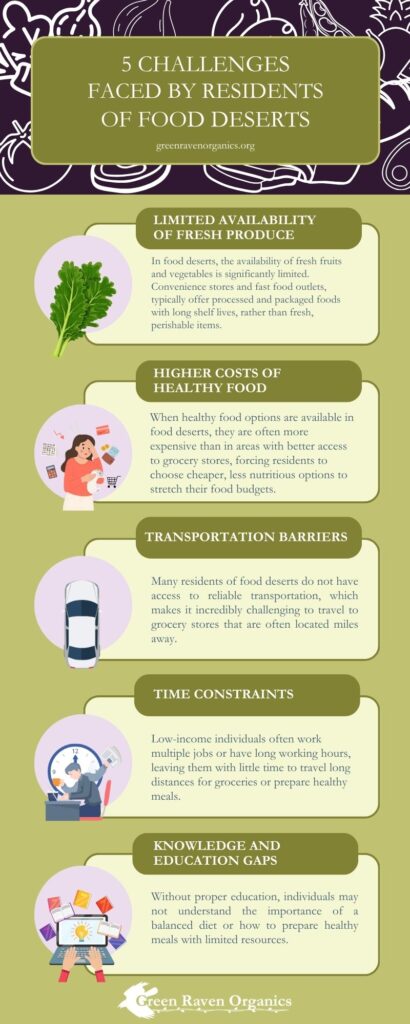The term “food desert” has gained significant attention as communities and policymakers grapple with the challenges of food insecurity. Food deserts are areas where residents have limited access to affordable and nutritious food, often resulting in poor dietary habits and adverse health outcomes. Addressing this issue is crucial, not just for individual health, but for the overall well-being of communities, particularly in urban settings like Charlotte, NC.
Food insecurity is a complex issue that stems from various socio-economic factors. In food deserts, access to healthy food options is scarce, and residents often rely on convenience stores and fast-food outlets that offer limited nutritional value. This lack of access perpetuates cycles of poverty and poor health, making it imperative to understand and address the root causes of food deserts.
In this blog, we will look into the concept of food deserts, explore the challenges faced by those living in these areas, and discuss viable solutions to improve food equity. Through highlighting local initiatives and successful strategies, we will shed light on the importance of community-driven efforts and policy changes in combating food deserts. Read more to learn about the intricacies of food deserts and explore ways to create healthier, more equitable food systems.
Understanding Food Deserts
Food deserts are geographic areas where residents have limited access to affordable and nutritious food. These areas are often characterized by a lack of supermarkets or grocery stores within a convenient traveling distance, particularly in low-income neighborhoods. Understanding the factors that contribute to the creation and persistence of food deserts is essential for developing effective solutions.
Definition and Characteristics of Food Deserts
Food deserts can be defined as areas, usually urban or rural, where access to healthy food is restricted due to the absence of grocery stores within a reasonable distance. This distance is typically considered to be more than one mile in urban areas and more than ten miles in rural areas. The U.S. Department of Agriculture (USDA) provides a more detailed definition and mapping tools to identify these areas.
Socio-Economic Factors Contributing to Food Deserts
Several socio-economic factors contribute to the emergence of food deserts, including:
- Income Levels: Lower-income households may lack the financial resources to travel to grocery stores or purchase healthier food options.
- Transportation Barriers: Limited access to reliable transportation makes it challenging for residents to reach stores that sell healthy food.
- Retail Disparities: Supermarkets and grocery stores are less likely to be located in low-income areas, where profit margins are perceived to be lower. This can also be referred to as “Supermarket Redlining”.
Health Implications of Living in a Food Desert

Residents of food deserts often suffer from higher rates of diet-related illnesses such as obesity, diabetes, and heart disease. This is due to the reliance on fast food and processed foods that are high in sugar, salt, and unhealthy fats. These health disparities are a direct result of limited access to nutritious food, underscoring the importance of addressing food deserts to improve public health.
Understanding food deserts is crucial for grasping the broader concept of food equity, which encompasses the idea that everyone should have access to nutritious and affordable food options regardless of their socio-economic status or geographic location. In our previous blog post on food equity, we explored how systemic disparities contribute to food insecurity and nutrition disparities within our communities.
Challenges Faced by Residents of Food Deserts

Residents of food deserts encounter numerous challenges that affect their ability to access nutritious and affordable food. These challenges contribute to the cycle of food insecurity and poor health outcomes. Understanding these obstacles is essential for developing effective interventions.
Limited Availability of Fresh Produce

In food deserts, the availability of fresh fruits and vegetables is significantly limited. Convenience stores and fast food outlets, which are more prevalent in these areas, typically offer processed and packaged foods with long shelf lives, rather than fresh, perishable items. This lack of availability makes it difficult for residents to maintain a balanced diet.
Higher Costs of Healthy Food
When healthy food options are available in food deserts, they are often more expensive than in areas with better access to grocery stores. The increased costs can be attributed to transportation expenses, limited supply, and higher operating costs for stores in low-income neighborhoods. This price disparity forces residents to choose cheaper, less nutritious options to stretch their food budgets.
Transportation Barriers
Many residents of food deserts do not have access to reliable transportation, which makes it incredibly challenging to travel to grocery stores that are often located miles away. Public transportation may be limited or non-existent, and taxi or ride-sharing services can be prohibitively expensive, and unpredictable with surge pricing. This lack of transportation options exacerbates the difficulty of accessing healthy food.
Time Constraints
Low-income individuals often work multiple jobs or have long working hours, leaving them with little time to travel long distances for groceries or prepare healthy meals. Time constraints can lead to a reliance on fast food or ready-made meals, which are typically less nutritious.
Knowledge and Education Gaps
Another challenge faced by residents of food deserts is a lack of knowledge about nutrition and healthy eating. Without proper education, individuals may not understand the importance of a balanced diet or how to prepare healthy meals with limited resources. Community education programs can play a crucial role in bridging this knowledge gap.
Solutions for Alleviating Food Deserts
Addressing the challenges faced by residents of food deserts requires a comprehensive approach that includes policy changes, community initiatives, and support from various stakeholders. Here are several effective solutions that can help alleviate food deserts and improve access to nutritious food.
Community-Based Initiatives
Urban Gardening Programs

Urban gardening programs empower communities to grow their own fresh produce. These initiatives transform vacant lots and underutilized spaces into productive gardens, providing residents with direct access to fruits and vegetables. Urban gardens not only improve food security but also foster community engagement and environmental stewardship.
Farmers Markets

Farmers markets bring fresh, locally grown produce directly to communities. They create opportunities for residents to purchase nutritious food at affordable prices, support local farmers, and stimulate the local economy. Farmers markets can be particularly effective in food deserts, where traditional grocery stores are scarce.
Policy Interventions
Government Subsidies and Incentives
Governments can play a crucial role in alleviating food deserts by providing subsidies and incentives for grocery stores and farmers markets to set up in underserved areas. These financial incentives can help offset the higher operating costs and encourage the establishment of food retailers that offer healthy options.
Zoning Regulations
Local governments can implement zoning regulations that encourage the development of grocery stores and farmers markets in food deserts. By prioritizing land use for food retailers in these areas, zoning policies can ensure that residents have better access to nutritious food.
Improving Transportation
Green Raven Organics’ Mobile Markets
Green Raven Organics’ Mobile Markets bring fresh produce directly to neighborhoods with limited access to grocery stores. These markets operate out of specially equipped vehicles that travel to different locations, making it easier for residents to purchase healthy food without needing reliable transportation.
Enhanced Public Transportation
Improving public transportation routes and schedules to better serve food deserts can help residents access grocery stores more easily. Partnerships between transportation authorities and community organizations can ensure that transit options are affordable and convenient for those who need them most.
Education and Awareness Programs
Nutrition Education
Community-based nutrition education programs can help residents of food deserts learn about healthy eating and how to prepare nutritious meals on a budget. These programs often include cooking classes, workshops, and resources that empower individuals to make healthier food choices.
Awareness Campaigns
Raising awareness about the existence of food deserts and their impact on health can mobilize community support and drive policy changes. Awareness campaigns can highlight the importance of food equity and encourage local businesses, non-profits, and government agencies to collaborate on solutions.
The Role of Community Support and Advocacy
Addressing food deserts and achieving food equity requires the active participation of community members, local organizations, and advocacy groups. By working together, communities can create lasting change and ensure that all residents have access to nutritious food.
Grassroots Movements
Local Food Councils
Local food councils are community-based organizations that bring together diverse stakeholders, including residents, farmers, business owners, and policymakers, to address food system issues. These councils can identify local needs, develop strategies to improve food access, and advocate for policies that support food equity.
Community Advocacy Groups
Community advocacy groups play a vital role in raising awareness about food deserts and mobilizing residents to take action. These groups often organize campaigns, host public forums, and work with local governments to advocate for better food policies and increased funding for food access programs.
Partnerships with Local Businesses
Grocery Store Collaborations
Partnering with local grocery stores can help improve food access in underserved areas. These partnerships can include initiatives such as establishing smaller grocery outlets in food deserts, offering delivery services to residents, or providing discounts on healthy food options.
Community Advocacy Groups
Local restaurants and cafes can also play a role in addressing food deserts by sourcing ingredients from local farmers and offering healthy, affordable meal options. These businesses can collaborate with community organizations to host cooking classes and nutrition workshops, further promoting healthy eating habits.
Support from Non-Profit Organizations
Green Raven Organics
As a leading non-profit organization dedicated to promoting food equity, Green Raven Organics (GRO) offers various programs and initiatives to improve food access in Charlotte, NC. From urban gardening projects to our unique Mobile Markets, GRO is committed to ensuring that all residents have access to nutritious and affordable food.
Other Non-Profits
Many other non-profit organizations work to address food deserts and food insecurity. These organizations often provide essential services such as food pantries, meal delivery programs, and educational resources. By collaborating with local communities, non-profits can help create sustainable solutions to food access challenges.
Educational Institutions
Schools and Universities
Educational institutions can contribute to food equity by incorporating nutrition education into their curricula and promoting healthy eating habits among students. Schools and universities can also establish partnerships with local farms and food producers to provide fresh, healthy meals in their cafeterias.
Research and Outreach Programs
Universities and research institutions can support food equity efforts by conducting studies on food access issues and developing innovative solutions. Outreach programs can engage students and faculty in community service projects, such as establishing school gardens or organizing food drives.
Volunteer Engagement
Community Volunteering
Volunteers play a crucial role in supporting food equity initiatives. Community members can get involved in various ways, such as helping to run farmers markets, assisting with urban gardening projects, or distributing food through local pantries and meal programs.
Corporate Volunteer Programs
Businesses can encourage their employees to volunteer with local food equity organizations. Corporate volunteer programs not only provide valuable support to these initiatives but also foster a sense of community and social responsibility among employees.
Fostering Food Equity: A Path Forward
In navigating the complexities of food deserts, it becomes clear that the journey towards food equity requires concerted efforts from individuals, communities, policymakers, and organizations like Green Raven Organics (GRO). By understanding the challenges faced by residents of food deserts and implementing holistic solutions that address socio-economic, environmental, and systemic factors, we can create healthier, more equitable food systems. By working together, we can create communities where everyone has the opportunity to thrive and lead healthy, fulfilling lives. Together we can cultivate a future where food equity is not just a goal, but a reality for all.




0 Comments